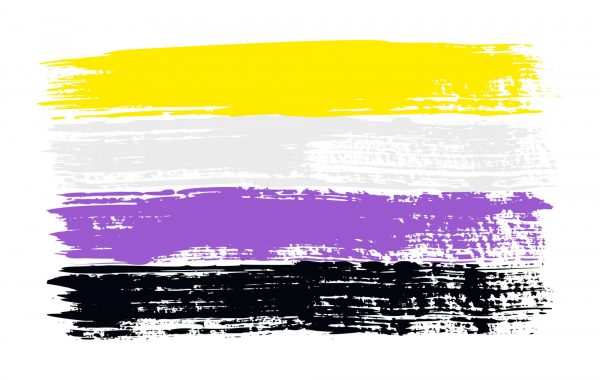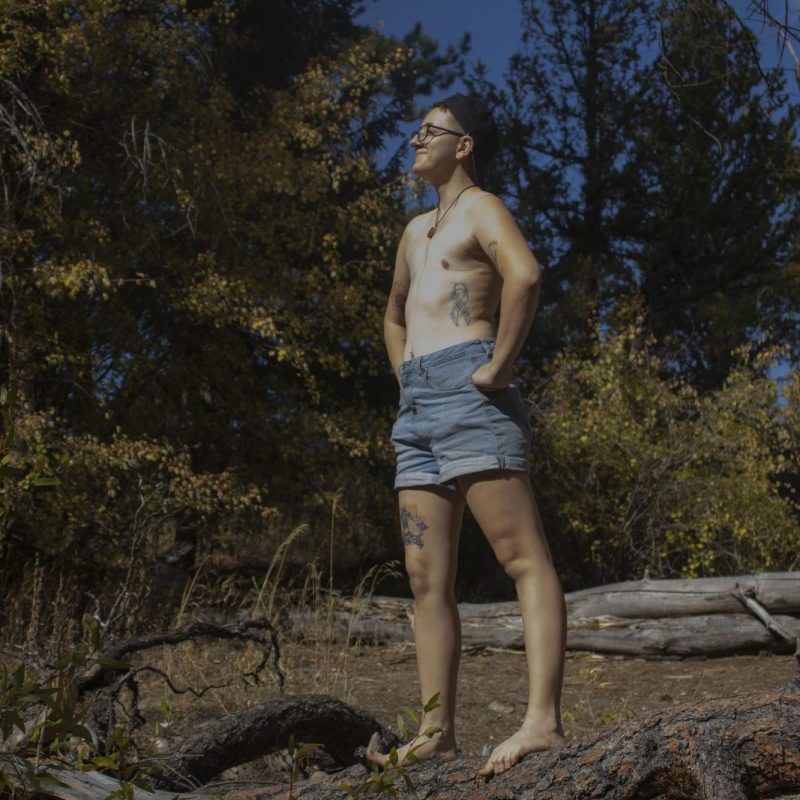
“My gender studies classes have helped open my eyes to the expansiveness of gender identity and the beauty of transness.”
Senior Aspen Moon, a sociology major with minors in women’s studies and legal studies, credits both friends and gender theory courses for supporting their gender journey over the last seven years. Moon doesn’t identify with either side of the gender binary (male or female), and instead identifies somewhere in the space beyond the binary. Moon has experimented with different combinations of pronouns but has found that they/them pronouns “feel like home.”
Moon realized as a teenager that something felt off about their gender identity but ignored it due to lack of access to gender-based education and being raised in a conservative community. In their sophomore year, Moon took their first gender studies course, “Gender and Society,” with Jacqulyn Gabriel. “Something that really resonated with me was the global and historical perspectives on gender identity in that class, including how transness was viewed from a U.S. perspective. We also had a transwoman as a guest speaker. While this wasn’t my first encounter with a trans person, it did solidify to me that this identity was something that exists. Transness was not something at the forefront of my imagination or even something I really knew much about until then,” Moon said.

Moon also credits their best friend for his openness to probing discussions about gender. When Moon admitted feeling a little confused about their gender, this friend reassured them, “however you identify is valid, and I will happily support you in any way, shape, or form.” Supported by an open and affirming friend group of majority queer folx, Moon socially transitioned in February 2020. Moon’s former partner identified as non-binary and supported Moon with things like binding, and other practices that people assigned female at birth do to quell gender dysphoria.
Moon has pursued medical transition as well, including top surgery this past spring. With the support of the CSU Health Network, Moon is continuing gender-affirming healthcare and has started a regimen of low-dose testosterone. The Transgender Health Team is a “multidisciplinary team committed to providing comprehensive gender-affirming care for transgender, gender non-conforming, and gender-questioning students at Colorado State University.” Moon praises this health care team as being “nothing short of amazing.” Moon found the health practitioners to be well-versed in all levels of transition options and was pleased that the practitioner took Moon’s lead when determining treatment. “That level of medical autonomy with my transition felt so wonderful and was really empowering,” they said.
Moon explains their identity now, “While ‘non-binary’ is a comfortable term for me, I often interchange it with ‘trans’ when describing my identity to others, as both are umbrella terms that make sense to me. Trying to pinpoint a specific facet of transness or a specific label to adhere to has never made sense to me personally, as I resonate with multiple facets of gender identity.”
After socially and medically transitioning, Moon continues to find gender theory and trans philosophy insightful in navigating their journey. For example, Moon took a course in feminist philosophies that includes philosophical pieces on gender and the body, such as a canonical piece by Judith Butler where she develops her theory of gender performativity. Butler describes gender as “the stylized repetition of acts through time.” By renewing, revising, and consolidating a series of behaviors over time, the body becomes its gender. In her theory, gender is not a stable social and cultural essence, but an emergent property of humans engaging with worlds of meaning. According to Butler, we recognize gender through the performance of actions, gestures, costumes, mannerisms, and styles understood as appropriate to a particular cultural and historical situation.
Butler’s concept of gender as performance really resonated with Moon’s experience and helped them conceptualize their identity in a new way. This theory helped Moon realize how presenting as the gender they were assigned at birth always felt performative, “like I had to dress really feminine so people would feel like I was valid.”
Moon explains how performativity relates to their gender expression: “I like to joke with my friends that I was cosplaying as a woman for a long time, and that I chose to wear that costume for the comfort of others. While I still actively participate in the performative aspect of gender in my day-to-day presentation—whether that’s more masculine, feminine, or androgynous—I am no longer performing for others. I am presenting as my true self, or at least a more authentic version of who I am.”
I am no longer performing for others. I am presenting as my true self, or at least a more authentic version of who I am.”
The feminist philosophies course also included pieces from specifically intersectional and trans perspectives, including Brooklyn Leo’s framing of gender as a trans person of color and from a two-spirit perspective. Moon explains, “Brooklyn Leo’s work really resonated with me because the standard U.S. understanding of gender is very binary and based on a colonial framework. Learning that gender has always been expansive has helped me to reject the strict binary I was raised in and to feel secure in my gender identity.”
For Moon, their gender identity is a journey: “It’s kind of just been a one-day-at-a-time journey. I really like just being able to exist as I am.”
Navigating Borders
From water to dance, science to film, clay to gender, the liberal arts helps us navigate the borders in our lives that are physical, metaphorical, or cultural.
